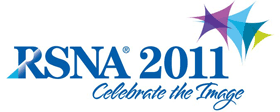
Abstract Archives of the RSNA, 2011
LL-CHS-MO6A
The Rate of Resolution of Clot Burden Measured from CT Pulmonary Angiography in Patients with Acute Pulmonary Embolism
Scientific Informal (Poster) Presentations
Presented on November 28, 2011
Presented as part of LL-CHS-MO: Chest
Ayaz Aghayev MD, Presenter: Nothing to Disclose
Alessandro Furlan MD, Abstract Co-Author: Nothing to Disclose
Amol Patil, Abstract Co-Author: Nothing to Disclose
Bum-Woo Park, Abstract Co-Author: Nothing to Disclose
Kyongtae Tyler Bae MD, PhD, Abstract Co-Author: Patent agreement, Covidien AG
Patent agreement, Bayer AG
Expert Advisory Committee, Bracco Group
To assess the rate of resolution of clot burden measured from CT pulmonary angiography (CTPA) in patients with acute pulmonary embolism (PE).
In a retrospective cohort study we evaluated 111 patients (55M, 56F, mean age, 52 years) who were diagnosed positive for PE in CTPA and had at least one follow-up CTPA performed within one year (January 1st – December 31st 2007). Two radiologists in consensus reviewed both the initial and follow-up CTPA to assess the presence of PE and measured the volume of each clot using a semi-automated quantification program. For patients with multiple PE’s, the total clot volume was calculated. The resolution rate of the total clot volume as well as the percentage volumetric change was assessed. The resolution rates of the central vessels (main and lobar arteries) versus the peripheral vessels (segmental and subsegmental arteries) were compared.
The follow-up CTPA was obtained with the mean of 68 days (range, 1-312 days). At the baseline CT, the meanSD clot volume per study was 3403.36505.6 mm3 (range 6.8- 3168.4 mm3). Overall, 85 patients (77%) showed a complete resolution in the follow-up CT. A complete resolution was seen in 61% (14 of 25 patients) in 1-7 days after the baseline CT, 84% (26 of 31 patients) between 29- 90 days, and 94% (32 of 34 patients) after 90 days. The total clot volume measurements summed for all patients decreased by 81% (central clot 78%, peripheral 84%) in 7 days, by 90% (central 88%, peripheral 93%) in 90 days, and by 98% (central 95%, peripheral 100%) after 90 days respectively.
Clot burden resolved completely in the majority (77%) of patients during the follow-up period of the study. The volumetric analysis demonstrated that clot resolved faster in the peripheral (segmental and subsegmental) than in the central (main and lobar) pulmonary arteries.
The clinical management of patients with PE continues to be controversial. Changes in clot burden measured at follow-up CTPA may provide a new insight in determining appropriate treatment and clinical
Aghayev, A,
Furlan, A,
Patil, A,
Park, B,
Bae, K,
The Rate of Resolution of Clot Burden Measured from CT Pulmonary Angiography in Patients with Acute Pulmonary Embolism. Radiological Society of North America 2011 Scientific Assembly and Annual Meeting, November 26 - December 2, 2011 ,Chicago IL.
http://archive.rsna.org/2011/11034602.html

